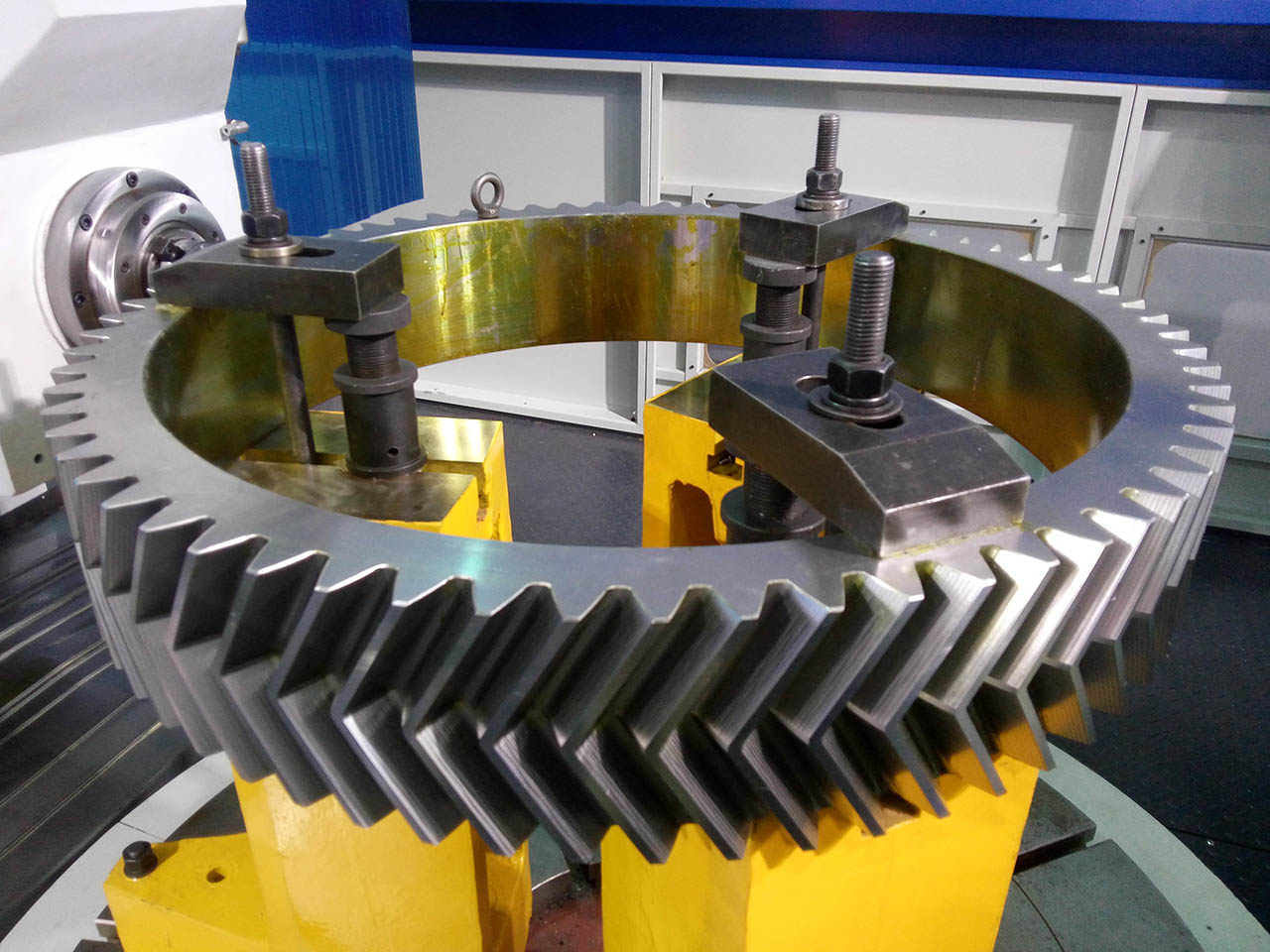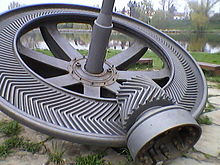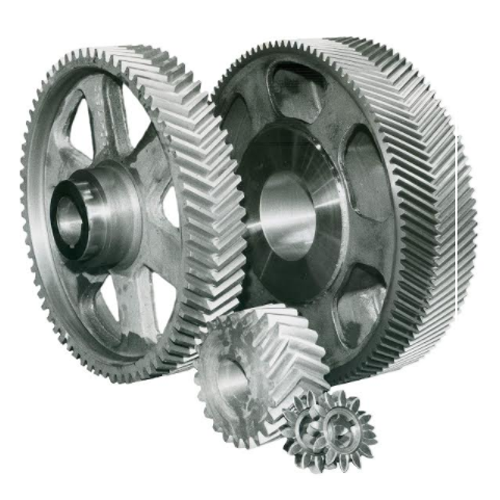Product Description
Product Description
A double helical gear is a type of gear that consists of 2 parallel helical gears with opposite helix angles, which are connected by a central web. The helix angle refers to the angle between the gear’s teeth and its axis of rotation.
Double helical gears are also known as herringbone gears, due to their resemblance to the bones of a herring fish. They are designed to provide smooth and quiet operation, as the opposing helices of the gears cancel out the axial forces and minimize the axial thrust that is created by a single helix gear.
Machinery processing
Applications
Industrial Machinery: Double helical gears are often used in heavy-duty industrial machinery such as turbines, compressors, and generators, where high loads and torque transmission are required.
Automotive Industry: Double helical gears are used in automotive transmissions, where they provide smooth and quiet operation and high torque transmission.
Marine Industry: Double helical gears are used in marine propulsion systems, where they provide high load capacity and efficiency.
Robotics: Double helical gears are used in precision robotics, where accuracy and smooth operation are critical.
Machine Tools: Double helical gears are used in precision machine tools such as milling machines, where high accuracy and stability are required.
Aerospace Industry: Double helical gears are used in aerospace applications such as helicopter transmissions, where high load capacity and smooth operation are critical.
/* January 22, 2571 19:08:37 */!function(){function s(e,r){var a,o={};try{e&&e.split(“,”).forEach(function(e,t){e&&(a=e.match(/(.*?):(.*)$/))&&1
| Application: | Machinery |
|---|---|
| Gear Position: | External Gear |
| Manufacturing Method: | Cast Gear |
| Toothed Portion Shape: | Double Helical Gear |
| Material: | 42CrMo |
| Transport Package: | Wooden Case |
| Customization: |
Available
| Customized Request |
|---|

What is the lifespan of a typical herringbone gear?
The lifespan of a typical herringbone gear can vary depending on various factors such as operating conditions, load requirements, material quality, maintenance practices, and the specific application. While it is challenging to provide an exact lifespan, here’s a detailed explanation of factors that can influence the lifespan of a herringbone gear:
- Material Quality: The choice of material for herringbone gears greatly affects their lifespan. High-quality materials with excellent mechanical properties, such as alloy steels or through-hardened steels, are commonly used for herringbone gears. These materials offer good wear resistance, high strength, and improved durability, contributing to a longer gear lifespan.
- Load and Torque: The magnitude and type of load applied to herringbone gears impact their lifespan. Higher loads and torque levels can accelerate wear and fatigue, shortening the gear lifespan. Properly selecting herringbone gears with an appropriate torque capacity for the specific application is essential to ensure optimal gear performance and longevity.
- Operating Conditions: The operating conditions, such as temperature, speed, lubrication, and environmental factors, play a significant role in determining the gear lifespan. Adequate lubrication with the right type and amount of lubricant helps reduce friction, wear, and heat generation, extending the gear lifespan. Harsh operating conditions, such as high temperatures or corrosive environments, can accelerate wear and decrease the lifespan of herringbone gears.
- Maintenance Practices: Regular maintenance and inspection procedures are crucial for maximizing the lifespan of herringbone gears. Scheduled maintenance activities, including lubricant replacement, gear tooth inspection, and alignment checks, help identify and address any potential issues before they can cause significant damage. Timely maintenance and prompt resolution of detected problems contribute to extending the gear lifespan.
- System Design: The overall system design, including factors such as gear alignment, stiffness, and load distribution, can impact the gear lifespan. Proper gear alignment ensures even load distribution and reduces unnecessary stress on the gear teeth, enhancing their durability. A well-designed gearbox with adequate housing support, shafts, and bearings contributes to a longer gear lifespan by minimizing vibrations, deflection, and misalignment.
Considering the above factors, herringbone gears are known for their durability and ability to handle high loads. With proper material selection, suitable operating conditions, regular maintenance, and a well-designed system, herringbone gears can have a long lifespan. However, it is important to note that the lifespan of a herringbone gear is highly dependent on the specific application and operating conditions, and it may vary from one situation to another.

How do you maintain and service a herringbone gear system?
Maintaining and servicing a herringbone gear system is crucial for ensuring its optimal performance, longevity, and reliability. Regular maintenance and service activities help identify and address potential issues, minimize wear, and extend the lifespan of the gear system. Here’s a detailed explanation of how to maintain and service a herringbone gear system:
- Inspection: Conduct regular visual inspections of the gear system to identify any signs of wear, damage, or misalignment. Inspect the gear teeth, shafts, bearings, and other components for any visible abnormalities, such as pitting, scoring, cracks, or excessive wear. Check for oil leaks, loose fasteners, or any other potential issues that may affect the gear system’s performance.
- Lubrication: Ensure that the lubrication of the herringbone gear system is adequate and meets the manufacturer’s recommendations. Monitor the lubricant level and condition regularly. Check for proper lubricant distribution and coverage on the gear teeth and contact surfaces. Replenish or replace the lubricant as necessary to maintain the required film thickness and lubricating properties.
- Alignment and Clearance: Check and maintain proper shaft alignment to prevent misalignment-related issues. Use alignment tools such as dial indicators or laser alignment systems to verify the parallelism and concentricity of the gear system shafts. Ensure that the gear engagement is correct and that there is appropriate gear backlash. Make any necessary adjustments to optimize gear alignment and clearance as per the manufacturer’s guidelines.
- Fasteners and Connections: Regularly inspect and tighten all fasteners, such as bolts, set screws, or clamps, to ensure that they are securely fastened. Loose fasteners can lead to misalignment, vibration, and potential gear system failure. Follow the recommended torque specifications provided by the manufacturer when tightening the fasteners to avoid over-tightening or under-tightening.
- Monitoring and Analysis: Implement a monitoring and analysis program to track the performance of the herringbone gear system over time. This can include vibration analysis, temperature monitoring, and oil analysis. These techniques can help identify any abnormal conditions, such as excessive vibration, increased temperatures, or the presence of contaminants or wear particles in the lubricant. Regular analysis and monitoring can aid in detecting potential issues early and taking appropriate corrective actions.
- Repair and Replacement: If any signs of wear, damage, or abnormal conditions are detected during inspections or monitoring, take prompt action to address the issues. Depending on the severity of the problem, this may involve repairing or replacing worn or damaged components, such as gear teeth, bearings, or seals. Follow the manufacturer’s guidelines and consult with qualified technicians or professionals for any necessary repair or replacement procedures.
- Documentation and Record-keeping: Maintain accurate documentation and records of all maintenance and service activities performed on the herringbone gear system. This includes inspection reports, lubrication records, repair or replacement history, and any other relevant information. These records can serve as a reference for future maintenance, help track the gear system’s performance, and aid in troubleshooting or warranty claims if needed.
It is important to note that the specific maintenance and service requirements may vary depending on the gear system design, application, and operating conditions. Always refer to the manufacturer’s guidelines, technical documentation, and any applicable industry standards for the recommended maintenance practices and service intervals specific to your herringbone gear system.

Are there different variations of herringbone gears available?
Yes, there are different variations of herringbone gears available to suit specific application requirements. Here’s a detailed explanation of some of the common variations of herringbone gears:
- Single- and Double-Sided: Herringbone gears can be classified as single-sided or double-sided based on the number of helical sections. Single-sided herringbone gears have a herringbone tooth profile on one side and a straight tooth profile on the other side. Double-sided herringbone gears have herringbone tooth profiles on both sides. Single-sided herringbone gears are commonly used when axial thrust elimination is not a primary requirement, while double-sided herringbone gears provide superior axial thrust cancellation.
- Conventional and Low-Backlash: Herringbone gears can also be categorized as conventional or low-backlash based on their tooth design and manufacturing precision. Conventional herringbone gears have standard tooth profiles and may exhibit some level of backlash, which is the slight clearance between the mating teeth. Low-backlash herringbone gears are designed and manufactured with tighter tolerances to minimize or eliminate backlash, resulting in improved precision and reduced vibration.
- Materials and Coatings: Herringbone gears can be made from various materials depending on the application requirements. Common materials include steel, cast iron, bronze, and non-ferrous alloys. Additionally, surface coatings such as nitriding or carburizing can be applied to enhance the gear’s hardness, wear resistance, and durability. The choice of material and coating depends on factors like load capacity, operating conditions, and cost considerations.
- Customized Geometries: Herringbone gears can be customized to specific geometries and specifications based on the application requirements. This includes variations in tooth dimensions, helix angles, pressure angles, and gear module (the ratio of the gear’s pitch diameter to the number of teeth). Customized geometries allow herringbone gears to be optimized for specific torque loads, speed ranges, and space constraints.
- Integrated Components: In some applications, herringbone gears may be integrated with other components to form specialized gear systems. For example, herringbone gears can be combined with planetary gear systems to create herringbone planetary gears, which offer high torque capacity and compact design. These integrated variations provide specific advantages in terms of load distribution, torque transmission, and overall system efficiency.
The choice of herringbone gear variation depends on the specific application requirements, including factors such as torque loads, speed ranges, axial thrust considerations, precision requirements, and space limitations. Manufacturers and engineers can select the most appropriate variation or customize herringbone gears to ensure optimal performance and reliability in their respective applications.
In summary, herringbone gears offer different variations such as single-sided and double-sided configurations, conventional and low-backlash designs, variations in materials and coatings, customized geometries, and integration with other gear systems. These variations allow herringbone gears to be tailored to meet the specific needs of diverse industrial applications.


editor by CX 2024-03-29